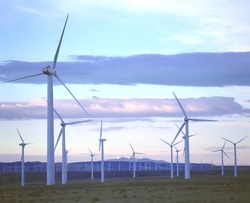Renewable Energy in Canada

Natural and renewable energies from the sun, wind, moving water, and biomass are forms of energy that do not threaten the sustainability of the earth’s systems, from which we as humans we depend on for our livelihood. The energy requirements that society needs for electricity, heating and cooling can be met by developing innovative technologies that use renewable energy sources such as wind, solar, and water. Canada is positioned at the leading edge of the worldwide renewable energy industry and British Columbia has just become the first provincial/state jurisdiction in North America to achieve carbon neutrality in public sector operation. Vancouver is one of the Canadian cities involved in this process. Here are some examples of renewable energies:
Wind energy: This is one of the fastest growing technologies for renewable energy, especially in Canada with an average annual growth rate of 60 percent since 1998 with installed capacity increasing from 26 megawatts (MW) in 1998 to 3,432 MW by the summer of 2010. Often installed in groups to form “wind power plants”, wind turbines convert moving air into electricity to be used locally or to be placed on electric grids that power homes and businesses further away. It does not require any fuel or produce greenhouse gas emissions. The energy produced can also be converted to hydrogen stored for subsequent power generation or used as a form of fuel. Canada is expected to experience significant growth in the upcoming years. Over 400 companies are members of the Canadian Wind Energy Association, with more than 6000 jobs.
Solar Thermal: Canada has a very large potential for solar energy use and leads the world in solar air collector development and commercialization. 544,000 m2 of solar collectors have been estimated operating in Canada since 2007. Sales have now captured approximately 30% of the solar market in Canada, and have been installed in 40 countries worldwide, including China’s Olympic site. CanmetENERGY’s, the Canadian leader in clean energy research and technology development has also developed the Canadian low flow solar water heater, considered by many to be the most cost-effective solar water heater system in the world.
Marine energy: The world’s tides, ocean waves and river currents all contain kinetic and potential energy, used to drive turbines and produce electricity. Wave energy is a concentrated form of solar energy: ocean waves form as a result of the sun heating the ocean surface. The motion of the waves can be used to power turbines or other power take-off systems to generate electricity. The waters off Canada’s Pacific and Atlantic coasts are rich with wave energy resources. Roughly 37,000 MW of total mean annual wave power off Canada’s Pacific coast—equal to more than 55 percent of the country’s annual electricity consumption. The potential capacity off Canada’s Atlantic coast is even greater: about 146,500 MW, or more than double current electricity demand.
Wind energy: This is one of the fastest growing technologies for renewable energy, especially in Canada with an average annual growth rate of 60 percent since 1998 with installed capacity increasing from 26 megawatts (MW) in 1998 to 3,432 MW by the summer of 2010. Often installed in groups to form “wind power plants”, wind turbines convert moving air into electricity to be used locally or to be placed on electric grids that power homes and businesses further away. It does not require any fuel or produce greenhouse gas emissions. The energy produced can also be converted to hydrogen stored for subsequent power generation or used as a form of fuel. Canada is expected to experience significant growth in the upcoming years. Over 400 companies are members of the Canadian Wind Energy Association, with more than 6000 jobs.
Solar Thermal: Canada has a very large potential for solar energy use and leads the world in solar air collector development and commercialization. 544,000 m2 of solar collectors have been estimated operating in Canada since 2007. Sales have now captured approximately 30% of the solar market in Canada, and have been installed in 40 countries worldwide, including China’s Olympic site. CanmetENERGY’s, the Canadian leader in clean energy research and technology development has also developed the Canadian low flow solar water heater, considered by many to be the most cost-effective solar water heater system in the world.
Marine energy: The world’s tides, ocean waves and river currents all contain kinetic and potential energy, used to drive turbines and produce electricity. Wave energy is a concentrated form of solar energy: ocean waves form as a result of the sun heating the ocean surface. The motion of the waves can be used to power turbines or other power take-off systems to generate electricity. The waters off Canada’s Pacific and Atlantic coasts are rich with wave energy resources. Roughly 37,000 MW of total mean annual wave power off Canada’s Pacific coast—equal to more than 55 percent of the country’s annual electricity consumption. The potential capacity off Canada’s Atlantic coast is even greater: about 146,500 MW, or more than double current electricity demand.
4 Natural Resources Canada CanmetENERGY, Leadership in ecoInnovation, www.nrcan.gc.ca
5 Industry Canada, http://www.ic.gc.ca/eic/site/wei-iee.nsf/eng/home
5 Industry Canada, http://www.ic.gc.ca/eic/site/wei-iee.nsf/eng/home
